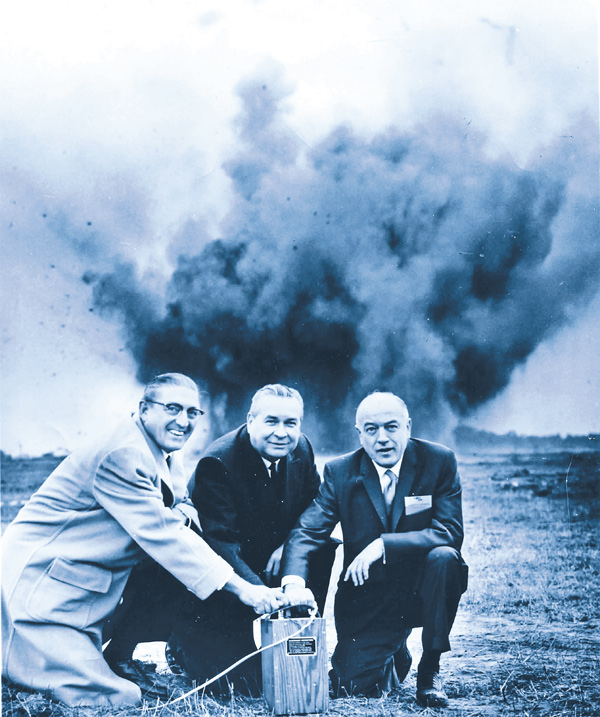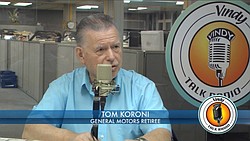GM Lordstown keeps cruzin’


Dynamite broke the ground at the General Motors “Lucky 13th” manufacturing complex in Lordstown on Sept. 29, 1964. Chevrolet General Manager Semon E. Knudsen, Ohio Gov. James A. Rhodes and Fisher Body General Manager Robert H. Gathman joined together in pushing the plunger to break ground on the plant. The new assembly plant was Chevrolet’s 13th in the United States.
Tom Koroni

Tom Koroni, a retiree of General Motors, talks about his early days in the steel mills and GM's Lordstown assembly plant.
By Kalea Hall
LORDSTOWN
Tom Koroni considers himself blessed. The General Motors retiree moved to Warren 48 years ago for one main reason: to work at the newly opened GM Lordstown plant.
“It was an education and a half,” he said.
Koroni, 76, still lives in Warren. He still drives a Chevrolet Impala, and he still sees the impact the plant has had on his life and on the Mahoning Valley.
“[Without it] this place would be a ghost town,” Koroni said.
Today, GM Lordstown celebrates the 50th anniversary of the groundbreaking for the plant.
Announcement
The first announcement of GM Lordstown came in February 1956. At the time, the plan for Lordstown was to adjoin two plants: Fisher Body and Chevrolet. It would be the largest manufacturing plant in Ohio, according to The Vindicator archives.
A photo printed with The Vindicator’s story on Feb. 17, 1956, shows farmland as the location for the plant. The 1,000-acre area was bounded by state Route 45, Young Road, Ellsworth-Bailey Road and the turnpike. Today, the total acreage at GM Lordstown is 905.
An estimated 8,000 workers were expected to be hired there, and between the two plants there was an expected $30 million to be spent annually in payroll.
GM Lordstown would “give the Youngstown district the biggest industrial impetus and probably the greatest population boost in its history, since 6,500 and 7,000 additional jobs will be created in service, supply and transportation industries serving the plants or their workmen or in additional public facilities or schools,” according to 1956 story in The Vindicator.
The plants were expected to be in full operation by July 1, 1958. They would rival local steel corporations in a variety of areas including the title of largest Valley employer.
The Vindicator reviewed the impact on the housing boom in Lordstown and surrounding communities, especially the quiet “Little Lordstown.” The thought was GM Lordstown would even create new communities.
The cost to build the plants was not revealed at the time, but the estimate was about $75 million.
“It will contribute importantly to the production required to meet the demand for our product, which exceeded 2,300,000 units in 1955,” said T.H. Keating, former GM general manager. “This will be our largest assembly plant thus far in employment, production capacity and area, a fact which bespeaks our confidence in northeastern Ohio as one of the nation’s expanding industrial and marketing areas.”
COMPLEX Plan
Ground would not be broken on the Lordstown plant until 1964. The plan was revived as part of a $2,000,000,000 expansion program by GM in the U.S. and Canada.
GM also would expand its Packard Electric Division that was in Warren.
“When the new plants are equipped and the added capacity is utilized, we would look forward to an increase of about 50,000 jobs available in this country,” said Frederic G. Donner, former GM chairman.
The Lordstown plants would assemble standard Pontiacs, standard-size Chevrolets, sporty Chevelles and small Tempests.
The $50,000,000-to-$75,000,000 plant would hire 4,500 at first with an expected expansion. The plan included a truck assembly plant.
There also would be a number of indirect jobs created through the Fisher Body and Chevrolet plants.
“When it goes into production in the summer of 1966, the Lordstown plant will begin assembling 1967 models at the rate of 50 cars per hour or about 800 a day, with a retail value between $2,000,000 and $2,500,000 on a two-shift basis,” according to The Vindicator archives.
IMPACT
Officials at GM Lordstown went through 35,000 applications to fill 2,500 positions to start the production process in April 1966.
Through the years the complex would go on to continue hiring and help to buffer the blow felt in the Mahoning Valley from the loss of the steel mills.
“I think a lot of people were concerned about the steel industry, but they didn’t think it would just stop,” said Bill Lawson, director of the Mahoning Valley Historical Society.
By 1973, GM Lordstown had made a $456 million impact on the local economy through payroll, property taxes and in other ways, Lawson said.
Many would make their way from the steel industry to the auto industry.
Koroni was one of those people. He went from working at U.S. Steel in Pittsburgh to GM Lordstown in 1966. Just two years after he started at GM Lordstown, the steel mill he worked in was gone. By 1985, 12,000 people worked at GM Lordstown, the highest number of workers in the plant’s history. Today, 4,500 people work there.
“I felt like I got out of an invasion,” he said.
Koroni retired from GM in 2000.
Lordstown Mayor Arno Hill has spent 21 years as an elected official and watched the impact the plant has had on the area.
“GM Lordstown carried this Valley after the steel mills went down,” he said. “If it weren’t for them, we would have been a ghost town.”
EMPLOYEE DEDICATION
GM seems to be in Jim Kralik’s blood. The 74-year-old Hubbard resident grew up with a father who worked for GM as the superintendent of production engineering at the Fisher Body Euclid Plant near Cleveland.
Kralik wanted to be an engineer, and he started to work at the assembly plant in Euclid and went on to receive a tool-and-dye apprenticeship. He also took night courses in engineering at what is now Cleveland State University.
It was common knowledge that Fisher Body was going to come to Lordstown, Kralik said.
“I had aspirations of moving up in a new plant,” he said.
And so he applied. He was the third toolmaker hired, but he thinks he would have been the first if his application hadn’t been lost.
“I am the type of person that gets bored with a job if I know it well,” Kralik said. “I was able to move up and never got bored.”
Within eight months at the plant, Kralik moved up to junior engineer and then on to process engineer and then senior engineer by 1970. Soon, he would become a general supervisor where he had all of the maintenance workers, toolmakers, millwrights, electricians and others to oversee.
“It was pretty much when I hit the front door they wanted this fixed and that fixed,” he said. “I couldn’t get to my office without being stopped.”
He retired with just short of 34 years at the plant, but in reality, he says, he probably worked 45 years once all of his overtime is taken into account.
“I think [GM Lordstown] gave the Valley a sense of reason,” Kralik said. “Without the Lordstown plant, I don’t know what would be left of Youngstown.”
Bill Arnaut, 63, of Boardman cannot stop working for GM Lordstown. He has been there for 45 years, but he says his retirement is coming.
He started at GM in the summer of 1970 at age 19 in the van plant. He ended up moving around the plant a lot.
“It was fun [back then] because we were all in our twenties,” he said. “It was hard and tedious, and we worked long hours.”
Today, he is the global manufacturing systems integrator.
“We teach team leaders and group leaders how to do their jobs,” he said. “The way we do the job now is all different. Safety and quality is a thousand times better than it used to be.”
Arnaut finds it rewarding to see the final result: the car that comes off of the line that he helped make happen.
“I helped put that there,” he said.
Cruzin’
The GM employees’ and the Valley’s beloved Chevrolet Cruze is the current vehicle under production at the Lordstown complex.
The love for the Cruze has extended beyond its roots to make it GM’s best-selling car. The Cruze has met many milestones in its four years of production.
In August 2012, GM announced a $200 million investment in the tooling and equipment at the complex for the next-generation Cruze. In addition, $20 million was invested at Parma, Ohio, GM facilities and 5,000 jobs were retained.
In February 2013, the public got a firsthand look at the Lordstown-built Chevrolet Cruze Clean Turbo Diesel at the Cleveland Auto Show.
In June 2013, the Cruze saw its highest volume of sales with 32,871 sold, according to The Vindicator archives.
This year, GM announced the investment of $50 million for a new flexible Trim Shop and upgrades to the Press Room at the Lordstown complex for the next-generation Chevrolet Cruze compact sedan.
And the millionth Cruze was built this year. The number keeps adding up with the estimated 1,200 Cruzes built every day.
Last Friday, the 2015 Cruze was shipped to dealers.
The Lordstown complex, the largest GM plant in the U.S. and most productive in North America, has built more than 15 million vehicles since opening in April 1966.
 43
43
